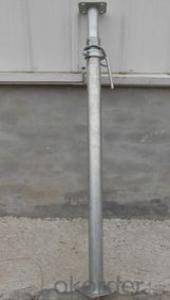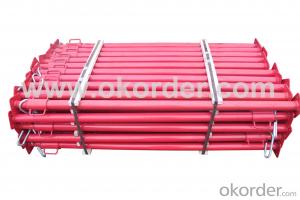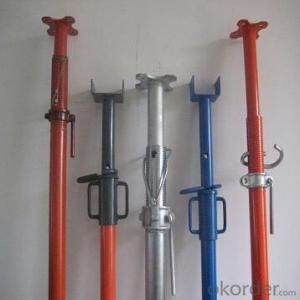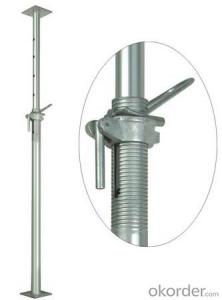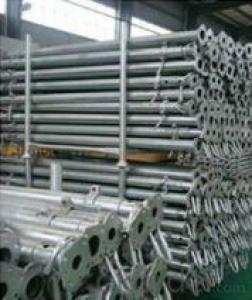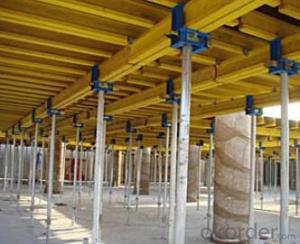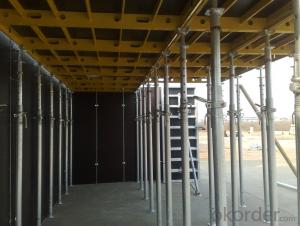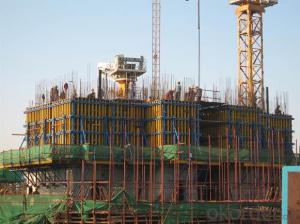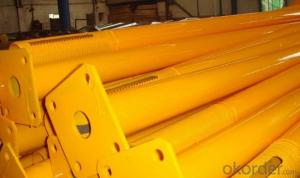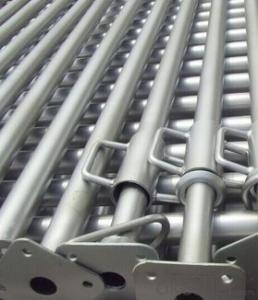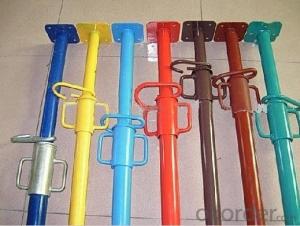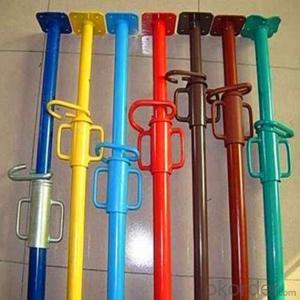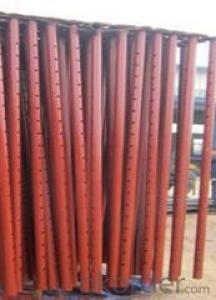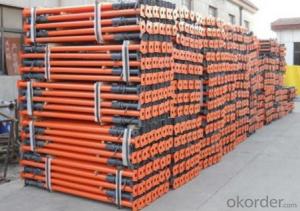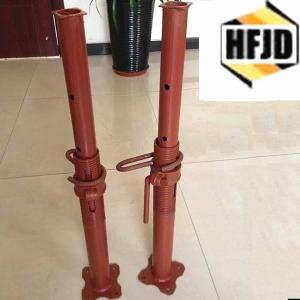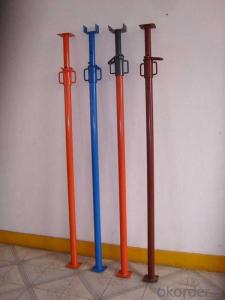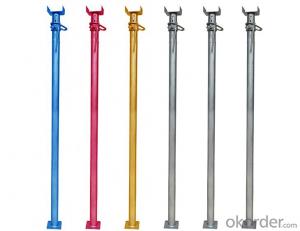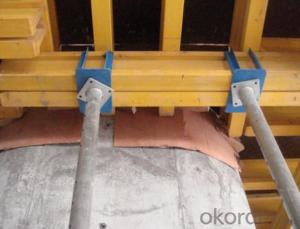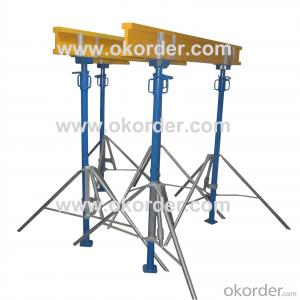U Head Scaffolding Steel Prop
- Loading Port:
- China Main Port
- Payment Terms:
- TT OR LC
- Min Order Qty:
- -
- Supply Capability:
- -
OKorder Service Pledge
OKorder Financial Service
You Might Also Like
Quick Details
| Brand Name: | Finish: |
Packaging & Delivery
| Packaging Detail: | Pallet |
| Delivery Detail: | within one month |
Specifications
Ringlock System
1. Vertical,Ledger,Transom,Diagonal Brace,Base Jack
2. EG, Dip Painting,HDG
3. Pallet Package
4.Q235,Q345
Ringlock System
1. Vertical,Ledger,Transom,Diagonal Brace,Base Jack
2. EG, Dip Painting,HDG
3. Pallet Package
4.Q235,Q345
Ringlock Scaffolding
Widely welcome around the world
Ringlock System is composed by Standard, Transom, Ledger;Diagonal Braces, board,etc...
We have a capability of 1000 Metric tons per month
We can supply Dip Painting Surface, HDG Surface and EG Surface
| Ringlock component | Specification (mm) | Weigtht (kg) | Material |
| Standards with Spigot | 500 | 3.09 | Q235/Q345 |
| 1000 | 5.49 | ||
| 1500 | 7.90 | ||
| 2000 | 10.30 | ||
| 3000 | 15.11 | ||
| 3500 | 17.51 | ||
| Ledgers | 750 | 3.20 | Q235 |
| 1000 | 4.07 | ||
| 1065 | 4.31 | ||
| 1200 | 4.78 | ||
| 1500 | 5.88 | ||
| 2000 | 7.56 | ||
| 2200 | 8.30 | ||
| 2500 | 9.35 | ||
| 3000 | 11.13 | ||
| Ladder | 3000 | 17.80 | Q235 |
| Braces | 750x2000 | 9.18 | Q235 |
| 1000x2000 | 9.47 | ||
| 1500x2000 | 10.31 | ||
| 2000x2000 | 11.40 | ||
| 2500x2000 | 12.67 | ||
| 3000x2000 | 14.06 |
Type of shoring props:
Shoring entails the construction of a temporary safety structure to prop up walls in a building that has become unstable due either to foundational expansion or natural disaster. The type of shoring a contractor chooses will depend on a specific building's structural status and the circumstances surrounding the building's weakness.
- Q: Can steel props be used in shopping center construction?
- Yes, steel props can be used in shopping center construction. Steel props provide strong and reliable support for structures during the construction process. They are commonly used to support temporary loads or to provide temporary bracing during construction work. Steel props offer adjustable height options and can easily be installed and dismantled, making them a versatile choice for various construction projects, including shopping center construction.
- Q: Are steel props suitable for supporting heavy loads?
- Steel props are indeed suitable for supporting heavy loads. Specifically, they are adjustable steel columns utilized in construction projects to provide temporary support for structures like beams, slabs, and formwork during construction or renovation endeavors. Made from top-notch steel, these props possess outstanding strength, durability, and load-bearing capacity. Notably, they are capable of supporting hefty loads and can be conveniently adjusted to the desired height and angle. Moreover, steel props come equipped with a broad base plate at the bottom, ensuring stability and preventing sinking or tilting when faced with significant loads. All in all, when it comes to supporting heavy loads in construction projects, steel props are an extremely dependable and efficient choice.
- Q: Can steel props be used in railway bridge construction?
- Yes, steel props can be used in railway bridge construction. Steel props provide strong support and stability, making them suitable for use in railway bridges where durability and load-bearing capacity are crucial.
- Q: Are steel props easy to install and dismantle?
- Yes, steel props are generally easy to install and dismantle. Steel props, also known as adjustable steel props or scaffolding props, are commonly used in construction projects to support temporary structures such as scaffolding, formwork, or shoring systems. The installation process usually involves positioning the props in the desired locations and adjusting their height according to the specific requirements of the project. Most steel props have an adjustable mechanism that allows for easy height adjustment, making it convenient to adapt to different construction needs. Similarly, dismantling steel props is typically a straightforward process. Once the temporary structure is no longer needed, the props can be easily removed by reversing the installation process. This usually involves lowering the props to their lowest height, releasing any locking mechanisms, and then removing them from their positions. Furthermore, steel props are often designed with lightweight materials, such as aluminum or steel alloy, which enhances their portability and ease of handling. This makes it easier for construction workers to install, adjust, and dismantle them as needed, saving time and effort during construction or renovation projects. However, it is important to note that the exact ease of installation and dismantling may vary depending on the specific design and manufacturer of the steel props. Additionally, proper training and adherence to safety guidelines are crucial to ensure the correct installation and dismantling procedures are followed, minimizing any potential risks or accidents.
- Q: How do you calculate the required height of a steel prop?
- To calculate the required height of a steel prop, you need to consider several factors. The primary consideration is the load that the prop will support. This load can be determined by adding the weight of the structure being supported, any additional loads such as equipment or materials, and any dynamic loads that may be present. Once the load is determined, you need to determine the safe working load (SWL) of the steel prop. The SWL is the maximum load that the prop can safely support without compromising its structural integrity. This information is typically provided by the manufacturer and can vary depending on the specific type and size of the prop. Next, you need to calculate the factor of safety (FOS) for the prop. The FOS is a measure of how much stronger the prop is compared to the expected load. It is typically a ratio of the SWL to the expected load, with a recommended FOS of around 2. This means that the SWL should be at least twice the expected load to ensure adequate safety. With the SWL and FOS determined, you can calculate the required height of the steel prop using the following formula: Required Height = (Load / (SWL / FOS)) Where the load is the total weight being supported and any additional loads, and the SWL/FOS is the safe working load divided by the factor of safety. It is important to note that this calculation provides an estimate of the required height, and it is always recommended to consult with a structural engineer or a qualified professional to ensure the accuracy and safety of the calculations.
- Q: How do you ensure proper stability of steel props on uneven surfaces?
- To ensure proper stability of steel props on uneven surfaces, it is important to follow a few key steps. Firstly, the ground should be properly prepared by removing any loose debris or obstacles that may hinder the stability of the props. Secondly, the base plates of the props should be securely positioned on a solid and level surface. If the surface is uneven, shimming or leveling the base plates may be necessary to ensure stability. Additionally, using adjustable props with telescopic sections can help compensate for uneven surfaces by allowing for height adjustment. Lastly, regular inspection and monitoring of the props' stability is essential to identify any potential issues and take corrective measures promptly.
- Q: What are the typical rental rates for steel props?
- The typical rental rates for steel props vary depending on factors such as location, duration of rental, and the quantity needed. It is best to contact local rental companies or suppliers to get accurate pricing information.
- Q: What are the safety precautions to take when using steel props?
- When using steel props, it is important to follow a few safety precautions to ensure a safe working environment. Firstly, always inspect the props before use to check for any signs of damage or defects. Secondly, make sure the props are properly installed and secured, following the manufacturer's guidelines. It is crucial to ensure that the props are stable and capable of supporting the intended load. Additionally, never exceed the weight capacity of the props and avoid overloading them. Regularly monitor the props during use and make necessary adjustments if any signs of instability or movement are observed. Lastly, always wear appropriate personal protective equipment, such as gloves and safety boots, when working with steel props to protect against potential hazards.
- Q: Can steel props be used for temporary support in power transmission tower construction?
- Yes, steel props can be used for temporary support in power transmission tower construction. Steel props are strong and durable, making them suitable for supporting heavy loads during the construction process. They can be easily adjusted and secured in place, providing stability and safety for workers and equipment. Additionally, steel props can be reused in different construction projects, making them a cost-effective choice. However, it is essential to ensure that the steel props meet the required specifications and standards to ensure their reliability and effectiveness in supporting the power transmission towers.
- Q: How do you prevent overloading of steel props?
- To avoid overloading steel props, several measures can be taken: 1. Determine the maximum load capacity: It is vital to know the steel props' maximum load capacity. This information can typically be obtained from the manufacturer or supplier. It is crucial not to surpass this limit to prevent overloading. 2. Perform accurate calculations: Before utilizing steel props, accurate calculations must be conducted to determine the required number of props and their spacing. These calculations should consider the load's weight, distribution, and any additional factors like wind or vibration. 3. Conduct regular inspections: Regular inspections are necessary to ensure the integrity and reliability of the steel props. Look for any indications of damage, such as cracks or deformations, that might compromise their load-bearing capacity. If any issues are identified, the props should be promptly replaced or repaired. 4. Ensure proper placement and alignment: When installing steel props, make sure they are placed on a solid and stable surface capable of supporting the load. It is essential to align the props correctly both vertically and horizontally to achieve even weight distribution. 5. Provide adequate bracing and support: Depending on the load's nature and the structure's height or length being supported, additional bracing or support may be required. This can help evenly distribute the load and prevent individual props from overloading. 6. Regularly monitor: It is essential to regularly monitor the steel props during use to ensure that the load does not exceed their capacity. This can be done by employing load monitoring devices or periodically checking the props for any signs of stress or strain. 7. Ensure proper training and supervision: It is crucial to guarantee that the personnel responsible for installing and using steel props receive proper training and supervision. They should possess a good understanding of load limits, calculation methods, and safety precautions to prevent overloading. By adhering to these preventive measures, the risk of overloading steel props can be significantly reduced, ensuring the safety and stability of the supported structure.
Send your message to us
U Head Scaffolding Steel Prop
- Loading Port:
- China Main Port
- Payment Terms:
- TT OR LC
- Min Order Qty:
- -
- Supply Capability:
- -
OKorder Service Pledge
OKorder Financial Service
Similar products
Hot products
Hot Searches
Related keywords
